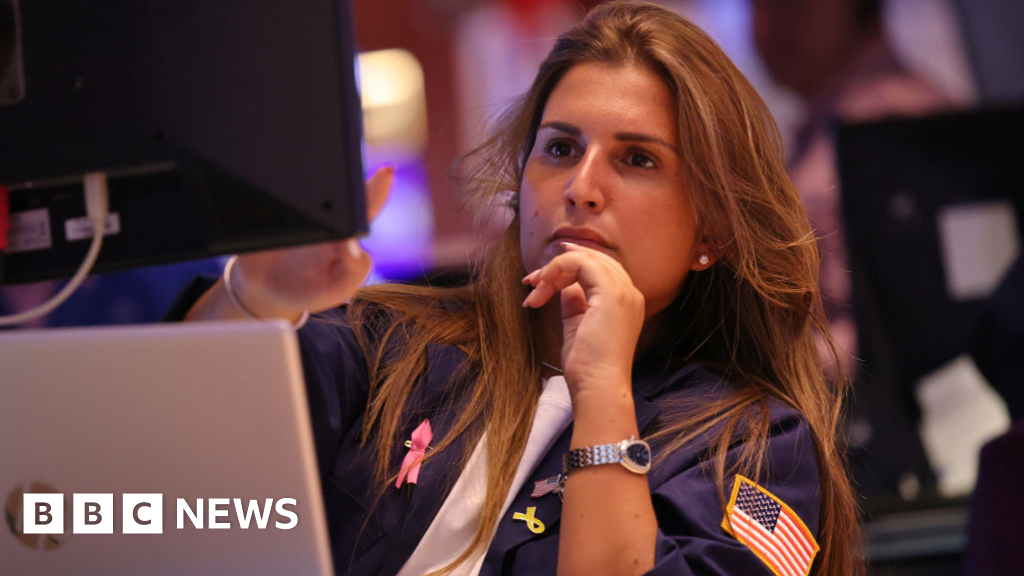Is the US economy heading for recession after stock market slump?

Over the past few days, global stock markets have been plummeting.
Trading screens across the US, Asia and, to a certain extent, Europe are awash with blinking red numbers heading south.
The sudden turn comes as fears grow that the US economy – the world’s biggest – is slowing down.
Experts say the main reason for this fear is that US jobs data for July, released on Friday, was much worse than expected.
However, for some, talk of an economic slowdown – or even a (whisper it) recession – is a little premature.
So, what did the official figures show us? As always with economics, there is good news and bad news.
Bad news first. US employers created 114,000 jobs in July which was way below expectations of 175,000 new roles.
The rate of unemployment also rose to 4.3%, a near three-year high, which triggered something known as the “Sahm rule”.
Named after American economist Claudia Sahm, the rule says if the average unemployment rate over three months is half a percentage point higher than the lowest level over the past 12 months then the country is at the beginning of a recession.
In this case, the US unemployment rate rose in July, so the three-month average was 4.1%. That compares to the lowest level over the last year which was 3.5%.
Adding to these concerns was the fact that the US Federal Reserve voted last week not to cut interest rates.
Other central banks within developed economies, including the Bank of England and the European Central Bank, have recently cut interest rates.
The Fed held borrowing costs but its chair, Jerome Powell, signalled that a cut in September was on the table.
However, this led to speculation that the Fed had waited too long to act.
A cut in interest rates means it is cheaper to borrow money which should, in theory, act as a boost to the economy.
If the jobs figures suggest that the economy is already tipping downwards, then the fear is the Fed is too late.
Then, on top of all this, are technology companies and their share prices. There has been a long-running rally in their shares, fuelled in part by optimism over artificial intelligence (AI).
Last week, the chip-making giant Intel announced it was cutting 15,000 jobs. At the same time, market rumours suggested that rival Nvidia may have to delay the release of its new AI chip.
What followed was a bloodbath on the Nasdaq, the technology-heavy US index. After hitting a high only a few weeks ago, it plunged by 10% on Friday.
That helped pump-up the fear factor across markets and that’s where danger could lie.
If stock market panic continues and shares keep plunging the Fed could potentially step in before its next meeting in September and cut interest rates.
This could happen, according to Neil Shearing, group chief economist at Capital Economics, if there is “a market dislocation that deepens and starts to threaten systemically important institutions and/or broader financial stability”.
Now for the good(-ish) news.
“We are not in a recession now,” according to Ms Sahm herself, inventor of the rule.
She told CNBC on Monday that “the momentum is in that direction”.
But she added: “A recession is not inevitable and there is substantial scope to reduce interest rates.”
Others are equivocal about the jobs data.
“While the report was bad it wasn’t that bad,” said Mr Shearing.
“It is likely that Hurricane Beryl contributed to weakness in July’s payrolls figure. Other data painted a picture of a labour market that is cooling, but not collapsing,” he said.
He added that there appeared to be “no increase in firings” while a “modest” decline in average weekly hours worked in July “does not scream ‘recession'”.
For Simon French, chief economist and head of research at Panmure Liberum, after digesting the US jobs data it’s time to take a moment.
“Stepping back, have we suddenly re-appraised the health of the world’s biggest economy? No and nor should we.”
But he added: “It is another data point at a time when liquidity is thin and you’ve got a lot of things to worry about.”
Related
U.S. economy adds jobs as federal layoffs and rising unemployment…
Julia Coronado: I think it's too early to say that the U.S. is heading to a recession. Certainly, we have seen the U.S. just continue t
The job listing site highlighting H-1B positions so Americans can…
A mysterious new job listings website recently went live, solely showing roles companies want to offer to their H-1B holders seeking Green Cards in an attempt t
Tepid February Jobs Report Boosts Odds of a June Fed…
Federal Reserve Board Chairman Jerome Powell speaks during a news conference. Photo by Chip ... [+] Somodevilla/Getty Images.Getty Images The February jobs repo
French university offers jobs to American scientists afraid of government…
As the current federal government in the U.S. has been freezing or cutting funding for several research grants, a French university has stepped in with an offer













